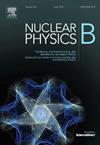研究f(R,∇R)引力中的重子熵比现象
IF 2.8
3区 物理与天体物理
Q2 PHYSICS, PARTICLES & FIELDS
引用次数: 0
摘要
本研究探讨了在修正引力框架下的重子发生,其中作用包含依赖于里奇标量R及其协变导数∇R的非局部核。这个扩展,被称为f(R,∇R)引力,通过引入可能影响早期宇宙动力学的附加导数项来推广传统的f(R)理论。在这个框架内,我们研究了宇宙尺度因子的四种不同形式:(i)中间尺度解,(ii)常规幂律展开,(iii)结合幂律和指数增长项的广义混合演化,以及(iv)对数中等尺度因子。我们引入了一个违反电荷宇称(CP)的相互作用项,它与组合里奇标量及其协变导数的时空导数线性缩放,表示为∂μ(R+∇R)。通过数值计算,我们通过计算无量纲比η - b来确定结果的重子不对称性,其中η - b表示重子数密度,s表示宇宙的熵密度。我们定量地比较了我们的理论预测的重子熵比η b,与目前的观测约束9.42×10−11。值得注意的是,我们的数值结果与这个经验建立的值非常一致,支持我们修改的引力框架在解释观测到的宇宙重子不对称性方面的可行性。本文章由计算机程序翻译,如有差异,请以英文原文为准。
Investigating baryon to entropy ratio phenomenon in f(R,∇R) gravity
This study explores baryogenesis within a modified gravitational framework where the action incorporates a non-local kernel dependent on the Ricci scalar R and its covariant derivative ∇R. This extension, referred to as gravity, generalizes traditional theories by introducing additional derivative terms that may influence early-universe dynamics. Within this framework, we examine four distinct forms of the cosmological scale factor: (i) an intermediate scaling solution, (ii) a conventional power-law expansion, (iii) a generalized hybrid evolution combining both power-law and exponential growth terms and (iv) logamediate scale factor. We introduce a charge-parity (CP) violating interaction term that scales linearly with the spacetime derivative of the combined Ricci scalar and its covariant derivative, expressed as . Through numerical computation, we determine the resulting baryon asymmetry by evaluating the dimensionless ratio , where represents the baryon number density and s denotes the entropy density of the universe. We quantitatively compare our theoretical predictions for the baryon-to-entropy ratio, , with the current observational constraint of . Notably, our numerical results demonstrate remarkable agreement with this empirically established value, supporting the viability of our modified gravitational framework in explaining the observed baryon asymmetry of the universe.
求助全文
通过发布文献求助,成功后即可免费获取论文全文。
去求助
来源期刊

Nuclear Physics B
物理-物理:粒子与场物理
CiteScore
5.50
自引率
7.10%
发文量
302
审稿时长
1 months
期刊介绍:
Nuclear Physics B focuses on the domain of high energy physics, quantum field theory, statistical systems, and mathematical physics, and includes four main sections: high energy physics - phenomenology, high energy physics - theory, high energy physics - experiment, and quantum field theory, statistical systems, and mathematical physics. The emphasis is on original research papers (Frontiers Articles or Full Length Articles), but Review Articles are also welcome.
 求助内容:
求助内容: 应助结果提醒方式:
应助结果提醒方式:


